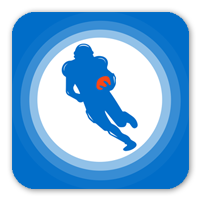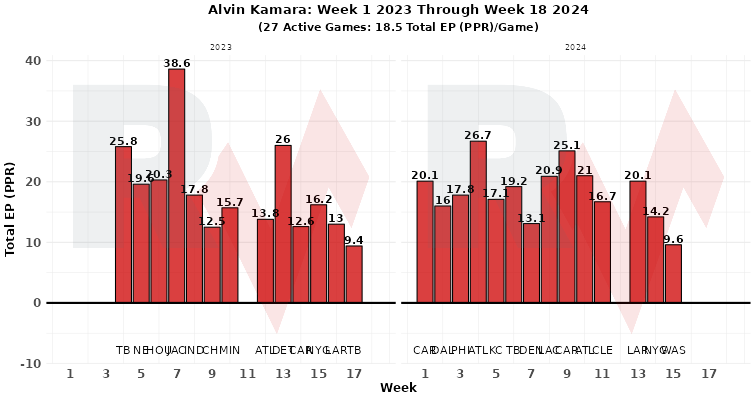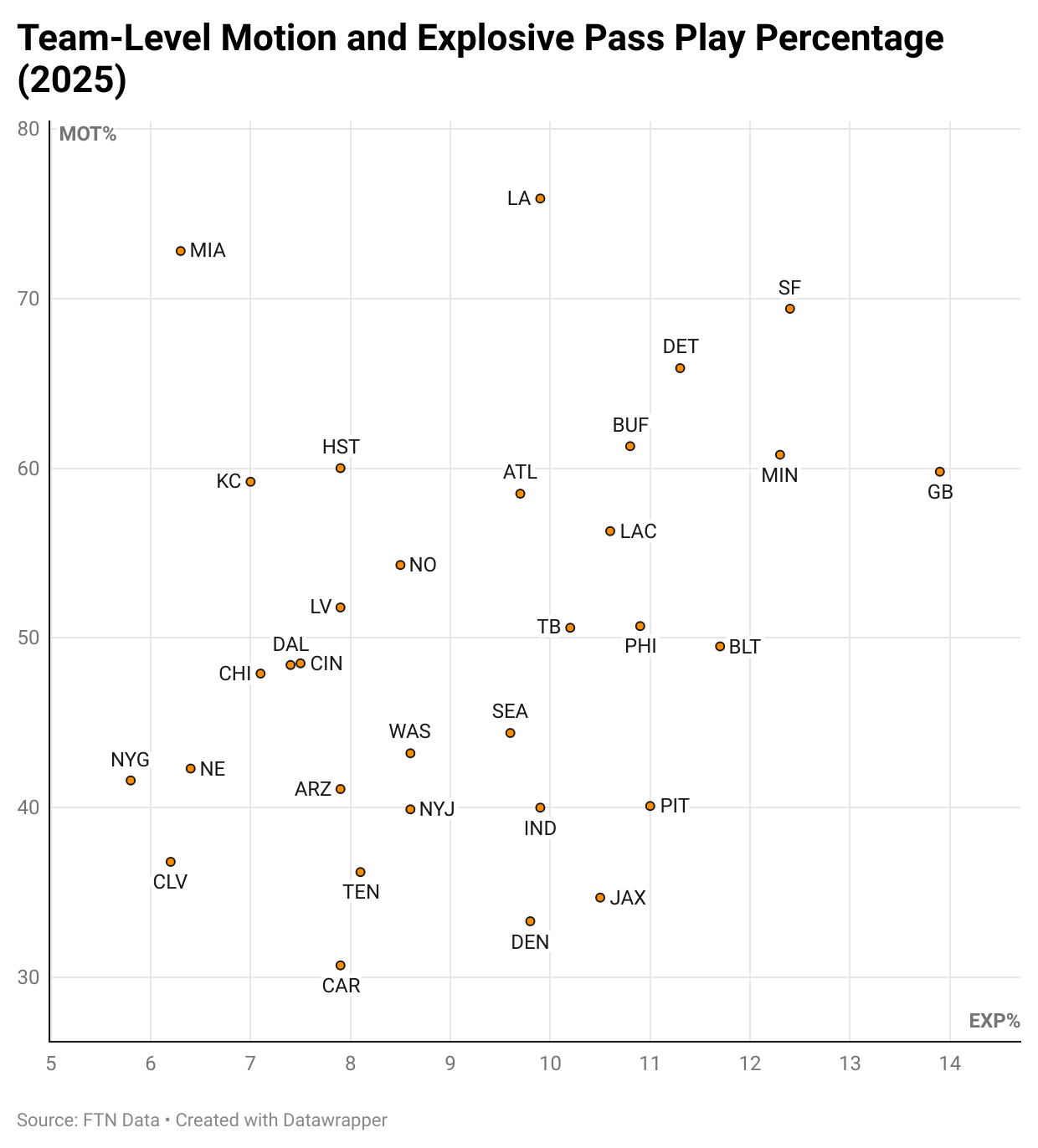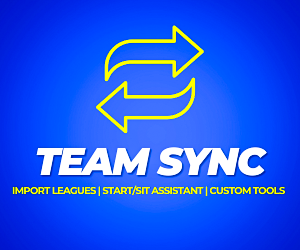Corbin's risky and boom-or-bust running back trade and draft targets for dynasty fantasy football leagues. His top RBs to acquire, including James Cook and more.
We've seen the running backs don't matter narrative thrown around, especially when you're a ZeroRB person like myself, especially in dynasty leagues. Fantasy managers need running backs to thrive in winning dynasty leagues, but the shelf life can be shortened since they're replaceable commodities. Like any risk-taking in life, we need to evaluate our risk tolerance because that impacts how we might manage our dynasty leagues. Defining risky players can be something discussed repeatedly.
However, one quick way to identify risky players involves examining a running back's dynasty average draft position (ADP) in Fantasy Football Players Championship (FFPC) start-up Leagues. Then we compare those ADPs to dynasty rankings to find where the market might be overvaluing the position. Not all the risky dynasty running backs are in the visual above, though it provides a starting point.
Be sure to check all of our fantasy football rankings for 2025:- 2025 fantasy football rankings
- Running back (RB) rankings
- Wide receiver (WR) rankings
- Quarterback (QB) rankings
- Tight end (TE) rankings
- Defense (D/ST) rankings
- Kicker (K) rankings
- FLEX rankings
- Dynasty rankings
We'll examine five running backs to target via trades and start-up drafts that might seem risky on the surface. However, these running backs have data to support at least 1-2 additional seasons for fantasy production beyond their market price in FFPC start-up drafts. It's a beefy one, so let's dive in.
Josh Jacobs, RB, GB
FFPC Dynasty ADP: 59.4 ADP, RB13
The Packers ranked first in neutral game script rush rate at 53 percent last season, ahead of the Eagles (52 percent), Colts (50 percent), and Ravens (50 percent). However, the Packers didn't quite have the same level of run blocking, given the Eagles, Colts, and Ravens ranking inside the top five in adjusted yards before contact per attempt. Meanwhile, the Packers posted a decent 2.06 adjusted yards before contact (No. 12).
Jacobs ranked 12th in EP/G, but he had one of his most efficient seasons, averaging 2.4 FPOE/G (No. 8). That's mainly because of Jacobs being an efficient runner, ranking eighth in rushing FPOE/G and scoring a career-best 15 rushing touchdowns. One could argue that Jacobs lacked competition because the Packers lacked competition, with Emanuel Wilson and Chris Brooks as their two primary backup options. The rookie MarShawn Lloyd was mostly injured (hip, hamstring, ankle).
Jacobs posted an above-average rate of missed tackles forced (19 percent), ranking 18th. He garnered 66.7 percent of his team's rush attempts inside the five-yard line (No. 13), which could suggest Jacobs could run into a high percentage of rushing scores again in 2025.
Summary
The Packers added two receivers on Day 1 in Matthew Golden and Savion Williams on Day 2. That could suggest the Packers may be attempting to be more balanced on offense. Meanwhile, they added zero running backs in the draft, with two undrafted free agents in Amar Johnson and Jalen White. Admittedly, the data pointed toward my love of Lloyd in the pre-draft process last off-season as a top-five running back in the class.
However, Jacobs should have the volume, with the advanced stats to support another RB1-type season. Players to consider trading away from Jacobs include Rome Odunze, Emeka Egbuka, or a late first-round pick in 1-QB dynasty leagues. The main risk with Jacobs involves the Packers becoming more balanced in neutral game scripts, especially with the additions of Golden and Williams in the draft.
James Cook, RB, BUF
FFPC Dynasty ADP: 70.3, RB18
The market continues screaming to sell, though Cook wasn't on the value of overvalued running backs based on FFPC Start-Up ADP. Cook was an uber-efficient rusher, scoring 16 touchdowns on 207 carries, ranking second in touchdown rate (7.7 percent) behind Roschon Johnson (10 percent). That translated to Cook averaging the fourth-most FPOE/G (4.2) behind Derrick Henry (6), Saquon Barkley (5.8), and Jahmyr Gibbs (5.8).
For context, those other three elite running backs averaged over 15 EP/G, meaning they handled a high-end workload. However, Cook averaged 11.5 EP/G, aligning with a workload closer to an RB2 or RB3. The Bills ranked 11th in neutral game script rush rate, with the 10th-best adjusted yards before contact per attempt. There's value in having one of the most prolific quarterbacks, Josh Allen, playing alongside Cook to help open up running lanes.
Cook evades tacklers, averaging a 20 percent missed tackles forced rate (No. 15) among rushers with 50 attempts. He led the team in rush attempts inside the five-yard line (48.4 percent), ahead of Allen (34.4 percent) and Ray Davis (9.4 percent). That's a significant change from 2023, when Cook garnered 14.3 percent of his carries inside the five while Allen had a whopping 40 percent of them. It could be something fluky or a concerted effort to have defenses guessing on who will take the ball inside the five.
Summary
Cook is a risky running back because he can, but doesn't garner tons of targets with Allen at quarterback. He peaked in Year 2 with 54 targets, translating to a 10 percent target share. However, Cook's eight percent target share from 2024 was still respectable. Furthermore, Cook should be due for regression in his rushing touchdown rate. For context, Cook was one of five running backs with a seven percent touchdown rate over the past two seasons.
Those other players included Roschon Johnson, Raheem Mostert, De'Von Achane, and Jeremy McNichols. Meanwhile, the rest of the list were quarterbacks. Besides Johnson and McNichols, Mostert was an outlier, with Achane gaining receiving volume. The Bills added veterans Joshua Palmer and Elijah Moore, with a seventh-round rookie receiver Kaden Prather. I wrote about Khalil Shakir being a dynasty start-up bust, given the historical comparisons.
Speaking of historical comparisons, Cook's closest ones include Bucky Irving, James Robinson, Chris Carson, James Conner, Kareem Hunt, and Mostert, according to the RotoViz Screener. There's a wide range of outcomes, including workhorse running backs to one- or two-year wonders. The dynasty market suggests acquiring Cook for Jacobs, a late first, Christian McCaffrey, or Xavier Worthy. Expect something in between 2023 and 2024 for Cook in 2025.
Alvin Kamara, RB, NO
FFPC Dynasty ADP: 98.1, RB24
Some of us have written off Kamara, but he continues to produce as an RB1 throughout his career. Kamara only has one season where he didn't rank as a top-10 running back in fantasy points (PPR/G), which was in 2022 when he ranked 13th. From an expected points standpoint, Kamara ranked in the top 10 in EP/G in seven out of eight seasons, with his rookie year as the lone outlier.
Kamara has been one of the most efficient running backs as a receiver, with the second-best yards per route run at 1.93 behind David Montgomery (2.54) among running backs with 25 targets. He garnered the highest targets per route rate (31 percent) in 2024 and 34 percent (No. 3) in 2023, with an equally efficient 1.86 yards per route (No. 5). Kamara earns targets at an elite wide receiver level, and that should continue into 2025.
Summary
Kamara has played with Andy Dalton, Jameis Winston, Derek Carr, and Spencer Rattler. The Saints drafted Tyler Shough in the second round, and he projects to be the starter for the Saints. Shough dealt with several injuries in college, including a broken collarbone in 2021, another collarbone issue in 2022, and a fractured lower leg in 2023. He flashed some rushing juice at Oregon and Texas Tech, which might impact the targets to Kamara if Shough remains healthy and uses his legs more often.
It feels scary acquiring a 30-year-old running back that isn't Derrick Henry. However, Kamara fits the profile we should want to invest in, even if it's a 1-2 year window. The tricky and risky part about Kamara involves what to give up for him in a trade. Maybe a future second-round pick, Rashod Bateman, Davante Adams, Shakir, or Trey Benson. If the volume and receiving efficiency had fallen off for Kamara, we would have more concerns, but it hasn't occurred yet.
D'Andre Swift, RB, CHI
FFPC Dynasty ADP: 113.1, RB28
The Bears were arguably one of the worst offenses in 2024, ranking 27th in EPA per dropback (EPA/DB) and 27th in success rate. It's easy to have more optimism around the Bears' offense with Ben Johnson joining the team since the Lions ranked second in EPA/DB and first in success rate. Swift garnered the most opportunities (305) of his career via the most rush attempts (253) in 2024.
Johnson and Khalil Herbert were discussed as threatening Swift's workload. However, the Bears traded Herbert to the Bengals since Johnson took on a larger workload. Johnson had a 31 percent snap share, 16 percent rush rate, and a five percent target share. Meanwhile, Swift posted career-bests via a 67 percent snap share and a 59 percent rush percentage with the Bears. Swift's previous high was in Philadelphia with a 58 percent snap share and a 47 percent rush percentage. Both seasons came with a 10 percent target share.
Swift used to be a near-elite rusher who evaded tons of tackles. However, those advanced metrics declined over the past two seasons, coinciding with the higher workload. That's evident in Swift's 13 percent missed tackles forced in 2024 (No. 41), slightly worse than his 17 percent MTF/Att in 2023 (No. 43). For context, Swift garnered the ninth-best MTF/Att at 26 percent.
The schematic potential in the Bears' offense should excite us because the Lions ranked fourth in motion percentage during pass plays behind the Rams, Dolphins, and 49ers. Meanwhile, the Bears ranked 19th in motion percentage in 2024 on pass plays. That should help open up running lanes for Swift, though he had a brutal 36.5 percent success rate on rushes with motion in 2024.
Summary
The Bears were one of the worst run-blocking teams last season, ranking 24th in adjusted yards before contact per attempt. They tied for the eighth-highest pass rate (56 percent) in neutral game scripts, showing the Bears tended to pass at a higher rate than expected. The Bears invested in a second-round left tackle, Ozzy Trapilo, and a sixth-round guard in Luke Newman via the NFL Draft. Meanwhile, the Bears acquired two veteran offensive linemen in Joe Thuney and Jonah Jackson early in the offseason.
That suggests that Ben Johnson and the Lions acknowledge they need to invest in the offensive line, where Detroit thrived, ranking fourth in adjusted yards before contact and allowing the fourth-lowest pressure rate in 2024. Overall, the Bears have been investing in their offense under Johnson, including Colston Loveland and Luther Burden III in the first two rounds. If we're projecting a step up for the Bears' offense in 2025, shouldn't Swift be part of that?
Rachaad White, RB, TB
FFPC Dynasty ADP: 171.9, RB53
We discussed White and Bucky Irving on the FFPC Insider Access Show with Eric Balkman in June because Irving's ADP skyrocketed in redraft and dynasty formats. However, it presents a value to target White, even with some risk. In Weeks 1-10, White led the backfield with a 62 percent snap share and a 13 percent target share while matching Irving in rush percentage (37-38 percent).
Irving took off in the latter half of the season, but he still shared snaps (51 percent), with an uptick in rush percentage (48 percent) and target share (11 percent) in Weeks 12-18. From Weeks 12-18, Irving ranked 12th in EP/G, with the 10th-best fantasy points over expected per game (FPOE/G). Interestingly, White's rushing advanced stats were similarly comparable to Irving in Weeks 1-10 compared to Weeks 12-18.
Irving had a 31 percent MTF/ATT, with White at 15 percent in Weeks 1-10. Irving had a 7.3 percent explosive rush rate with White at 3.8 percent in Weeks 1-10. Explosive rush rate indicates the percentage of rush attempts that went for 15+ yards. From Weeks 12-18, Irving rocked a 22 percent MTF/Att, with White at 13 percent. Meanwhile, Irving (6.3 percent) doubled White (3.1 percent) in explosive rush percentage. It's not surprising that Irving has more juice and explosiveness than White as a rusher.
Summary
The FFPC dynasty market has Irving's 40.4 dynasty ADP as RB7, but it's slightly behind the redraft crowd, with an ADP of 21.7. There's a slim chance for Irving to take over the full volume of the Buccaneers' backfield. That opens up a path for White to be a cheaper option, but White needs the receiving volume because he doesn't force many missed tackles. Players to consider moving for White include Rhamondre Stevenson, Pat Bryant, Jonnu Smith, and Jarquez Hunter.
Download Our Free News & Alerts Mobile App
Like what you see? Download our updated fantasy football app for iPhone and Android with 24x7 player news, injury alerts, rankings, starts/sits & more. All free!

More NFL Rookie Analysis





 RADIO
RADIO




































